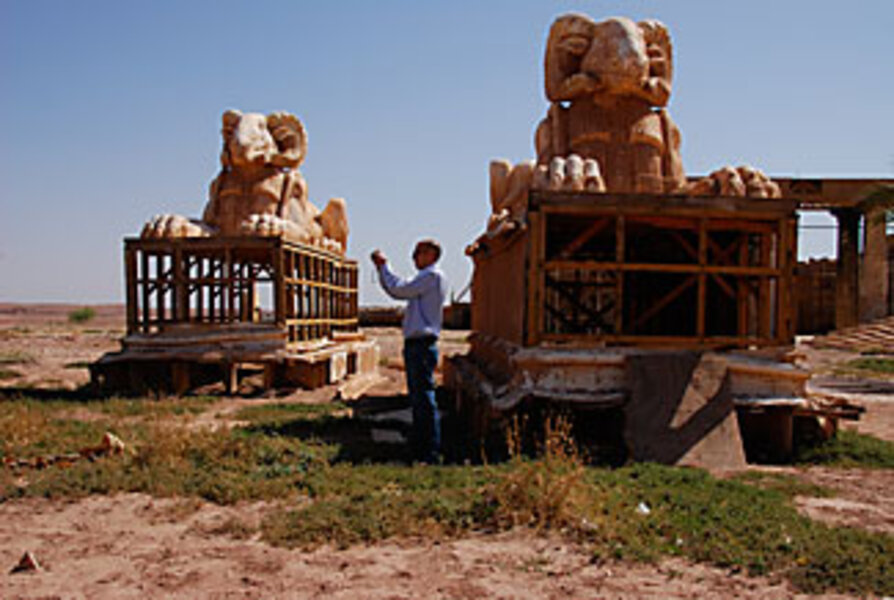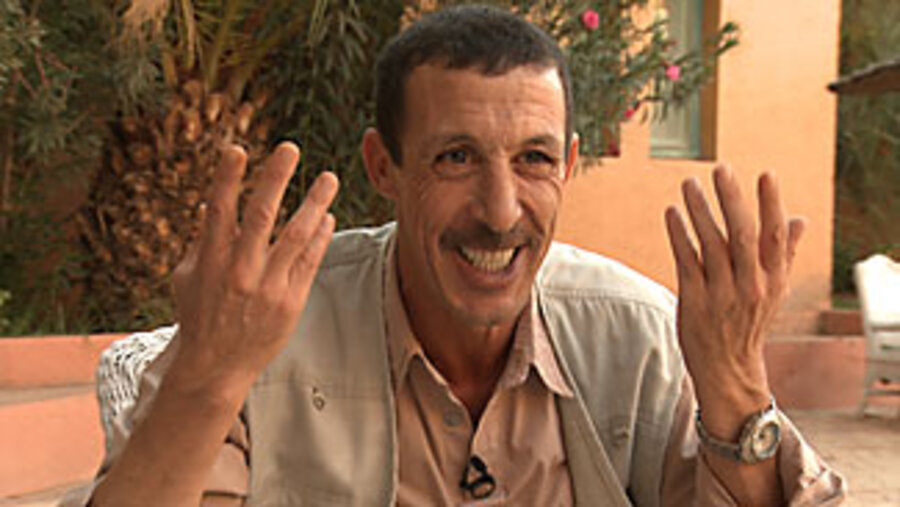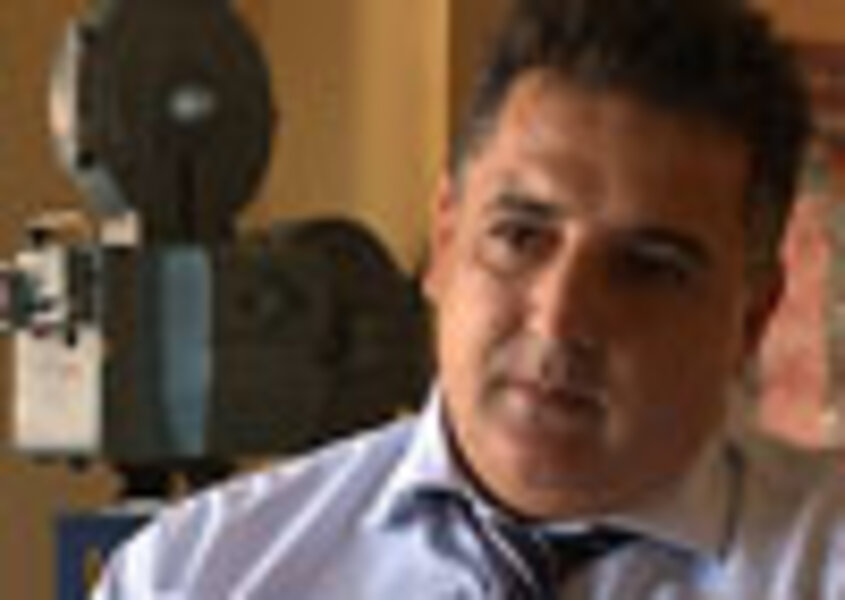Why Morocco went Hollywood
Loading...
| Ouarzazate, Morocco
In the deep south of a country where few locals drink, fewer speak English, and the metric system reigns supreme, you'll find a derelict gas station whose sign promises, "Cold beer. Last stop 200 miles."
It's one of several structures near this garrison town that may disrupt a visitor's expectations. Just to the north, a European-style medieval castle rises from the rocky plain. Closer to town, a pair of grimacing, gold-painted lions guard a Tibetan temple that's been slightly damaged by fire.
The buildings are all sets from American films – "The Hills Have Eyes 2," "Kingdom of Heaven," and "Kundun," respectively – and they represent traces of a multimillion-dollar industry that has bloomed in the Moroccan desert. Without realizing it, filmgoers worldwide have seen a remarkable number of this country's landscapes onscreen. The locations are sometimes unadorned, sometimes computer-enhanced, but they're nearly always standing in for somewhere else.
"I didn't have any clue about it," says Gonçalo Gomes, a Portuguese vacationer who spent a recent morning poking around Moroccan backdrops from "Gladiator," "The Mummy Returns," and "Jewel of the Nile."
"In Portugal, we don't have a big industry for films," he says. "We just assume that every single one of them is made in studios in Hollywood."
Morocco's film trade embodies many of the contradictions facing this modernizing Muslim nation. Here, camera-friendly vistas conceal endemic poverty; the stability loved by studios issues from a king who brooks little dissent; and one of the Arab world's more tolerant, peaceful countries has embraced an industry that dwells consistently on the region's violence.
"Body of Lies," "Stop-Loss," and the upcoming Matt Damon vehicle "Green Zone" are just a few of the Iraq war films made here since the conflict began. The pattern vexes Jack Shaheen, the Lebanese-American author of "Guilty: Hollywood's Verdict on Arabs After 9/11" and other books critiquing Arab media stereotypes.
"These images represent everything Morocco is not," Dr. Shaheen says. "They're the same images that are repeated over and over again, so that when people hear the word Arab or Muslim, they automatically think violence."
Moroccan officials insist audiences are savvy enough to distinguish between life and art. "Let's be a little bit adult about this – it's fiction," says Nour Eddine Sail, director of the Moroccan Film Center, a government agency that regulates the film trade. And there are few incentives for thinking otherwise. "If we refuse a film, nothing stops an American producer from making it in a studio," Mr. Sail says.
In 2008, foreign directors shot more than 600 television and movie projects in Morocco, including 16 feature-length films, by the government's count. Sail estimates that foreign productions bring more than $50 million to the country each year. To keep that money coming in, authorities give tax breaks to film productions and even offer logistical help from the Moroccan military.
The latter practice dates back to some of the earliest foreign films shot on Moroccan soil. A column of Turkish troops massacred by Peter O'Toole's character in the 1962 epic "Lawrence of Arabia" was played in large part by soldiers on loan from the Moroccan Army.
Morocco's spectacular terrain and abundant light make cinematographers swoon, but big productions find a more compelling reason to come, says Amine Tazi, general manager of the Casablanca-based Atlas and CLA Studios, whose sets have graced dozens of American films. "The bottom line is, it's very cheap."
That's largely due to low wages. A Moroccan extra earns the equivalent of about $30 a day – hardly union scale, but a solid day's pay in a country where the World Bank estimates the national average is one-fifth of that.
The salary helps explain the allure even small film-industry jobs have here. "When there's two films in town, everybody works," says Mike Fowley, a set designer who splits his time between Ouarzazate, Morocco, and Aylesbury, England.
But when no productions are in town, "it's very hard in Ouarzazate," says Mustapha Rachidi, who moved here more than 20 years ago from his hometown of Fez. "There's nothing else. Always in the cafes you hear people talking about which production just arrived, or which one is going to get here soon."
Money is only part of the story. Ouarzazate was once merely a stopover for Sahara-bound travelers. Now, small as it is, the dusty provincial town has become a sort of third-world Los Angeles. Would-be actors, extras, and technicians flock here from across Morocco, all hoping somehow to make it in film.
Mr. Rachidi has been more fortunate than most. He longed to act, he says, but his parents couldn't afford to put him through school. Early on, he found work in Ouarzazate painting sets, then began steadily picking up gigs as an extra. Rachidi has appeared in more than 30 foreign productions, by his estimate, from gnat-sized parts in crowded epics to a nonspeaking role fighting alongside Jean-Claude Van Damme in "Legionnaire."
Then came the big break. Rachidi's name may not be a household word, but there's a chance you'd remember his distinctive, somber face from the 2006 film "Babel." Sharing the screen with Brad Pitt, Rachidi played his first speaking role as the father of a young boy who inadvertently shoots the female star, Cate Blanchett.
"I don't have to work as a painter now, God willing," Rachidi says. On a recent trip to Europe – the perk of another film job – Rachidi says he was startled to find his image in print. "My name, my face, my photo in a newspaper," he says. "You won't find it in Morocco."
Foreign productions are distributed more widely abroad than in Morocco, and the actor says he's still unknown at home. Other extras said they don't even own copies of the movies in which they appear.
But this doesn't seem to diminish Aimad Qaddi's enthusiasm for the work. In his day job, Mr. Qaddi leads tours of Atlas Studios in Ouarzazate, showing off sets from "Cleopatra," "The Hills Have Eyes," and the like. "Everything is fake here, all right? Genuine fake," Qaddi joked to one group on a recent morning. "Nothing real here. Just me."
Qaddi is an encyclopedia of Moroccan-made flicks, and not just the desert ones. "Black Hawk Down"? Filmed in the Moroccan city of Salé. The Beirut bits from "Spy Game"? Casablanca, he said.
Qaddi himself played specks in various crowds needed for "Gladiator," "Kingdom of Heaven," and the Viggo Mortensen movie "Hidalgo." "It's not easy to find me," he said, laughing.
Ask Qaddi what job he really wants, and he begins with the humility that's a verbal requisite in a pious land, using the Arabic word for "God willing." Then the dream kicks in.
"Inshallah," he says, "movie star."







